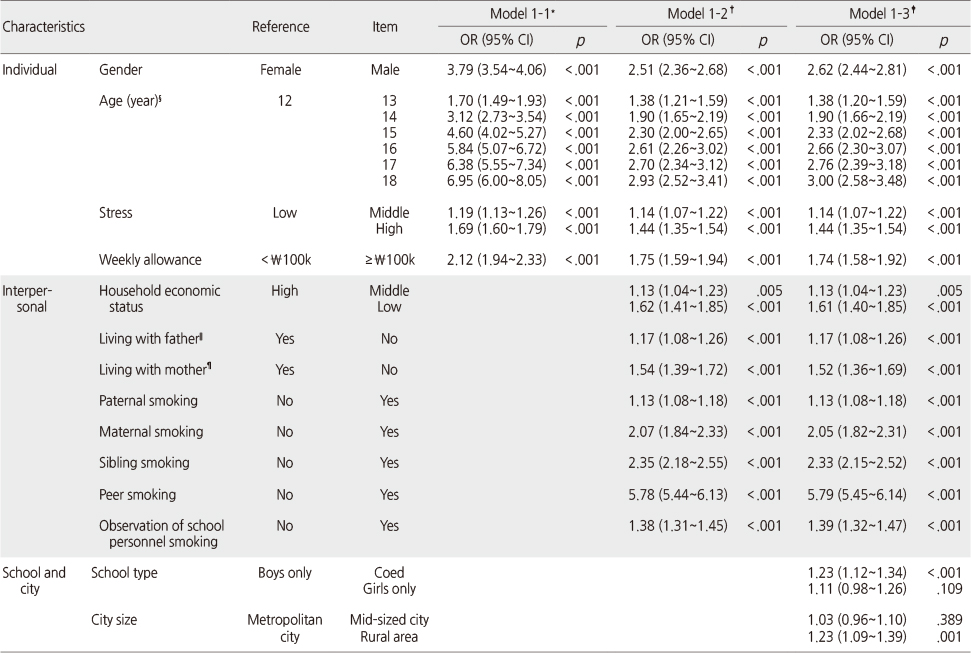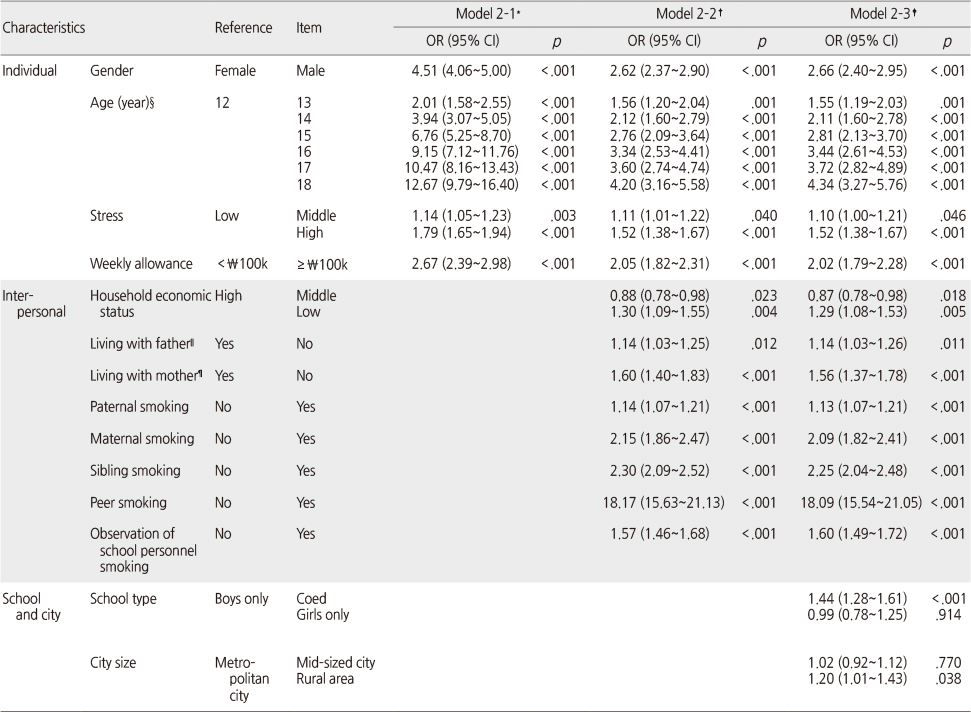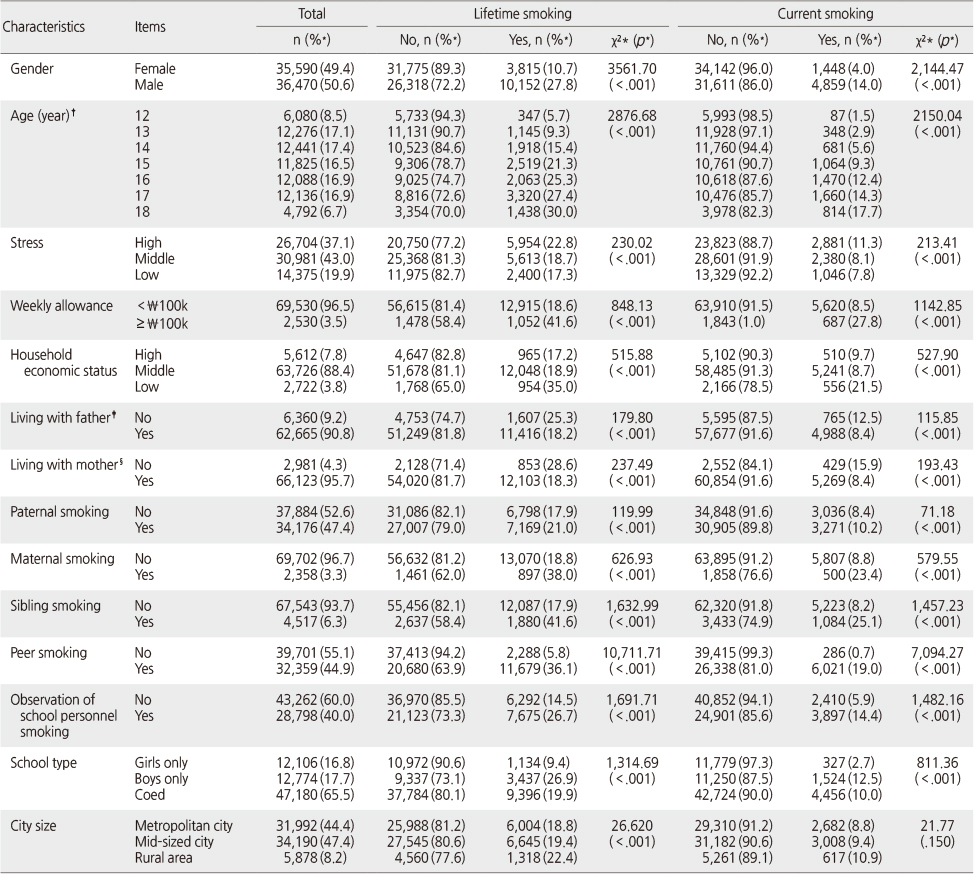Articles
- Page Path
- HOME > J Korean Acad Nurs > Volume 46(4); 2016 > Article
-
Original Article
- Factors Influencing Adolescent Lifetime Smoking and Current Smoking in South Korea: Using data from the 10th (2014) Korea Youth Risk Behavior Web-Based Survey
- Seok Hyun Gwon, Suyong Jeong
-
Journal of Korean Academy of Nursing 2016;46(4):552-561.
DOI: https://doi.org/10.4040/jkan.2016.46.4.552
Published online: August 31, 2016
1College of Nursing, University of Wisconsin-Milwaukee, Milwaukee, WI, U.S.A.
2College of Nursing, Seoul National University, Seoul, Korea.
- Address reprint requests to: Jeong, Suyong. College of Nursing, Seoul National University, Daehak-ro 103, Jongno-gu, Seoul 03080, Korea. Tel: +82-2-740-8489, Fax: +82-2-740-8489, mulyong1@snu.ac.kr
© 2016 Korean Society of Nursing Science
This is an Open Access article distributed under the terms of the Creative Commons Attribution NoDerivs License. (http://creativecommons.org/licenses/by-nd/4.0/) If the original work is properly cited and retained without any modification or reproduction, it can be used and re-distributed in any format and medium.
Abstract
-
Purpose
- The purpose of this study was to investigate factors influencing lifetime smoking and current smoking among adolescents in South Korea.
-
Methods
- Hierarchical logistic regression was conducted based on complex sample analysis using statistics from the 10th (2014) Korea Youth Risk Behavior Web-Based Survey. The study sample comprised 72,060 adolescents aged 12 to 18.
-
Results
- The significant factors influencing adolescent lifetime smoking were female gender, older age, higher stress, higher weekly allowance, lower economic status, living apart from parents, parental smoking, sibling smoking, peer smoking, observation of school personnel smoking, and coed school compared to boys' school. The significant factors influencing adolescent current smoking were female gender, older age, higher stress, higher weekly allowance, both higher and lower economic status compared to middle economic status, living apart from parents, parental smoking, sibling smoking, peer smoking, observation of school personnel smoking, and coed school compared to boys' school.
-
Conclusion
- Factors identified in this study need to be considered in programs directed at prevention of adolescent smoking and smoking cessation programs, as well as policies.
- 1. U.S. Department of Health and Human Services. Preventing tobacco use among youth and young adults: A report of the surgeon general[Internet]. Atlanta, GA, U.S. Department of Health and Human Services, Centers for Disease Control and Prevention, National Center for Chronic Disease Prevention and Health Promotion, Office on Smoking and Health. 2012;cited 2015 October 1. Available from: http://www.surgeongeneral.gov/library/reports/preventing-youthtobacco-use/full-report.pdf
- 2. Ko SJ, Jung YH. Estimating smoking-attributable deaths on adolescent in Korea. Health Welf Policy Forum. 2013;198:18–26.
- 3. Cho KS. Prevalence of hardcore smoking and its associated factors in Korea. Health Soc Welf Rev. 2013;33(1):603–628.Article
- 4. Ministry of Education, Ministry of Health and Welfare, Korea Centers for Disease Control and Prevention. The tenth Korea youth risk behavior web-based survey. Osong: Korea Centers for Disease Control and Prevention; 2014.
- 5. World Health Organization. Tobacco control country profiles[Internet]. Geneva, CH, Author. 2015;cited 2015 October 1. Available from: http://www.who.int/tobacco/surveillance/policy/country_profile/en
- 6. Ministry of Health and Welfare. National health plan 2020. Seoul: Author; 2011.
- 7. Kim W. Predictors of smoking behavior in Korean male and female youth. J Future Oriented Youth Soc. 2014;11(2):63–85.
- 8. Kim JK, Kim GH. Determinants of smoke and smoking frequency among middle and high school students. Forum Youth Cult. 2013;33:88–117.
- 9. Kang LJ, Kim HS. Risk and protective factors related to cigarette smoking among Korean male high school students. Consumption Cult Study. 2005;8(4):121–142.
- 10. Kim KH, Chung HK. A study on factors affecting experience of smoking in middle school girls. J Korean Acad Child Health Nurs. 2005;11(1):14–22.
- 11. Kim JE, Cho BH. The impact of social relationships on adolescents' smoking behavior. Stud Korean Youth. 2012;23(1):57–87.
- 12. Park SH, June KJ. Predictors affecting smoking initiation and an increase in smoking frequency among Korean middle schoolers. Stud Korean Youth. 2007;18(1):5–27.
- 13. Yang KH, Kim YH, Lee JR. Factors affecting middle school students' smoking behavior. J Korean Community Nurs. 2005;16(1):40–48.
- 14. Cho SH, Eom AY, Jeon GS. The effects of socio-economic status on drinking and smoking in Korean adolescents. Korean J Health Serv Manag. 2012;6(4):13–25.Article
- 15. Yu JO, Jung HY, Kim YM, Kwon SJ. Urban-rural disparities and related factors in rates of smoking by Korean adolescents. J Korean Acad Rural Health Nurs. 2013;8(1):33–41.
- 16. Centers for Disease Control and Prevention. Data guide-Health topics. Smoking status[Internet]. Atlanta, GA, Author. 2016;cited 2016 April 18. Available from: http://dhds.cdc.gov/guides/healthtopics/indicator?I=smokingstatus
- 17. Bewick V, Cheek L, Ball J. Statistics review 14: Logistic regression. Critical Care. 2005;9(1):112–118. PubMedPMC
- 18. Paavola M, Vartiainen E, Haukkala A. Smoking, alcohol use, and physical activity: A 13-year longitudinal study ranging from adolescence into adulthood. J Adolesc Health. 2004;35(3):238–244. ArticlePubMed
- 19. Park MB, Kim CB, Nam EW, Hong KS. Does South Korea have hidden female smokers: Discrepancies in smoking rates between self-reports and urinary cotinine level. BMC Womens Health. 2014;14:156ArticlePubMedPMCPDF
- 20. Park SH, Kang JH, Chun JS, Oh HJ. A longitudinal comparative study of mental health between adolescent smokers and adolescent nonsmokers. J Adolesc Welf. 2010;12(2):75–94.
- 21. Kim HO, Jeon MS. The relationship between smoking, drinking and the mental health in adolescents. J Korean Acad Public Health Nurs. 2007;21(2):217–229.
- 22. Goodman E, Huang B. Socioeconomic status, depressive symptoms, and adolescent substance use. Arch Pediatr Adolesc Med. 2002;156(5):448–453.ArticlePubMed
- 23. Ryu SY. An exploratory study of the relationship between adolescent part-time work experience and behavioral adjustments. Stud Korean Youth. 2005;16(1):255–281.
- 24. Huver RME, Engels RCME, Van Breukelen G, de Vries H. Parenting style and adolescent smoking cognitions and behaviour. Psychol Health. 2007;22(5):575–593. Article
- 25. Brown BB. Visibility, vulnerability, development, and context: Ingredients for a fuller understanding of peer rejection in adolescence. J Early Adolesc. 1996;16(1):27–36.
- 26. Berndt TJ, Keefe K. Friends' influence of adolescents' adjustment to school. Child Dev. 1995;66(5):1312–1329.PubMed
- 27. Lim YS. Peer relationship in adolescence. National Youth Policy Institute. Adolescent psychology. 2nd ed. Paju: Kyoyookbook; 2014. p. 383–413.
- 28. Fleming CB, White HR, Oesterle S, Haggerty KP, Catalano RF. Romantic relationship status changes and substance use among 18- to 20-year-olds. J Stud Alcohol Drugs. 2010;71(6):847–856. ArticlePubMedPMC
- 29. McCarthy WJ, Mistry R, Lu Y, Patel M, Zheng H, Dietsch B. Density of tobacco retailers near schools: Effects on tobacco use among students. Am J Public Health. 2009;99(11):2006–2013. ArticlePubMedPMC
REFERENCES
Factors Influencing Lifetime Smoking (N=72,060)

*Nagelkerke R2 was 0.162 (Cox and Snell R2was 0.102); †Nagelkerke R2 was 0.298 (Cox and Snell R2 was 0.185); ‡Nagelkerke R2 was 0.300 (Cox and Snell R2 was 0.186); §Skipped responses were excluded (n=71,638); ∥Skipped responses were excluded (n=69,025); ¶Skipped responses were excluded (n=69,104); CI=Confidence interval; OR=Odds ratio.
Factors Influencing Current Smoking (N=72,060)

*Nagelkerke R2 was 0.161 (Cox and Snell R2 was 0.073); †Nagelkerke R2 was 0.310 (Cox and Snell R2 was 0.136); ‡Nagelkerke R2 was 0.315 (Cox and Snell R2 was 0.138); §Skipped responses were excluded (n=71,638); ∥Skipped responses were excluded (n=69,025); ¶Skipped responses were excluded (n=69,104); CI=Confidence interval; OR=Odds ratio.
Figure & Data
REFERENCES
Citations

- A Study on Adolescent Smoking Prevention and Cessation Policies: Based on the Propensity Score Matching–Difference-in-Differences Method
Seokmin Ji, Byungchan Moon, Younggyu Kwon, Kyumin Kim
Healthcare.2024; 13(1): 30. CrossRef - Estimated prevalence and trends in smoking among adolescents in South Korea, 2005–2021: a nationwide serial study
Hyoin Shin, Sangil Park, Hyunju Yon, Chae Yeon Ban, Stephen Turner, Seong Ho Cho, Youn Ho Shin, Jung U. Shin, Ai Koyanagi, Louis Jacob, Lee Smith, Chanyang Min, Young Joo Lee, So Young Kim, Jinseok Lee, Rosie Kwon, Min Ji Koo, Guillaume Fond, Laurent Boye
World Journal of Pediatrics.2023; 19(4): 366. CrossRef - Health-Related Behavior and Psychosocial Characteristics of Adolescent Female Smokers in Korea, Compared with Adolescent Male Smokers
Yong-Sook Eo, Yeon-Hee Lee, Myo-Sung Kim
Healthcare.2023; 11(12): 1707. CrossRef - Disparity between Subjective Health Perception and Lifestyle Practices among Korean Adolescents: A National Representative Sample
Aniceto Echalico Braza, Jinsoo Jason Kim, Sun Hee Kim
Journal of Lifestyle Medicine.2022; 12(3): 153. CrossRef - Comparison of the Prediction Model of Adolescents' Suicide Attempt Using Logistic Regression and Decision Tree: Secondary Data Analysis of the 2019 Youth Health Risk Behavior Web-Based Survey
Yoonju Lee, Heejin Kim, Yesul Lee, Hyesun Jeong
Journal of Korean Academy of Nursing.2021; 51(1): 40. CrossRef - Factors Associated with Cigarette, E-Cigarette, and Dual Use among South Korean Adolescents
Myong Sun Cho
Healthcare.2021; 9(10): 1252. CrossRef - The Effect of Neighborhood Characteristics and Friends' Smoking Status on the Habitual Smoking Onset in Adolescents
You-Jung Choi, Gwang Suk Kim
Journal of Korean Academy of Nursing.2021; 51(1): 54. CrossRef - Sex Differences in Multilevel Factors of Smoking Experimentation and Age of Initiation in Korean Adolescents
Eun-Mi Kim, Eunhee Park, Heejung Kim
The Journal of School Nursing.2020; 36(5): 348. CrossRef - Multidisciplinary Approach to Smoking Cessation in Late Adolescence: A Pilot Study
Jae Suk Park, Sang Hyung Lee, Ga Hye Lee, Mi Ra Yang, Inhyuk Park, Bumjo Oh
Global Pediatric Health.2020;[Epub] CrossRef - Factors associated with maintenance of smoking cessation in adolescents after implementation of tobacco pricing policy in South Korea: Evidence from the 11th Youth Health Behavior Survey
Eun Gyeong Kim, Sook Kyoung Park, Young‐Me Lee, Mi Yeol Hyun, Laren (Riesche) Narapareddy
Research in Nursing & Health.2020; 43(1): 40. CrossRef - The Association Between Part-time Job Experience and Tobacco Smoking in Adolescents: Analysis on Korea Youth Risk Behavior Survey Data 2017
Kyoungmi Ku, Keum Ji Jung, San Kang, Yoonjeong Choi, Su Hyun Lee, Jakyoung Lee, Heejin Kimm
Journal of the Korean Society for Research on Nicotine and Tobacco.2020; 11(2): 56. CrossRef - Adolescent Abuse and Smoking Behavior Among High School Students in the Republic of Korea
Junghee Kim, Sunhee Park
Journal of Child and Family Studies.2019; 28(1): 52. CrossRef - The influence and interaction of exposure to pro-smoking
and anti-smoking messaging on youth smoking behaviour
and susceptibility
Jingfen Zhu*, Jiahui Li*, Yaping He#, Na Li, Gang Xu#, Jinming Yu
Tobacco Induced Diseases.2019;[Epub] CrossRef - Association Between Socioeconomic Status and Early Initiation of Smoking, Alcohol Drinking, and Sexual Behavior Among Korean Adolescents
Mei Lin C. Valencia, Binh Thang Tran, Min Kyung Lim, Kui Son Choi, Jin-Kyoung Oh
Asia Pacific Journal of Public Health.2019; 31(5): 443. CrossRef - Parent educators for teenage smoking behavior
Lucky Herawati, Johan Arief Budiman, Choirul Hadi, Abdul Khair
International Journal of Adolescent Medicine and Health.2019;[Epub] CrossRef - A Meta-Analytic Study on Differences between Middle and High School Students in Cognitive, Emotional and Social Variables Related to Adolescent Smoking
김인용, 강정석
Locality and Globality: Korean Journal of Social Sciences.2018; 42(3): 83. CrossRef - Impact of nearby smoking on adolescent smoking behavior in Korea
Dong Jun Kim, Sun Jung Kim
Medicine.2018; 97(45): e13125. CrossRef - Trend Analysis for the Choice and Cost of Lung Cancer Treatment in South Korea, 2003-2013
Dohun Kim, So Young Kim, Beomseok Suh, Jong Hyock Park
Cancer Research and Treatment.2018; 50(3): 757. CrossRef - Concept analysis of impressionability among adolescents and young adults
Seok Hyun Gwon, Suyong Jeong
Nursing Open.2018; 5(4): 601. CrossRef - An Exploratory Study of Factors Associated with Male Adolescents’ Perception of Graphic Health Warnings Covering Tobacco Packages
Kim Eun Soo, 정민수
Health and Social Welfare Review.2017; 37(3): 568. CrossRef
Characteristics depending on Lifetime Smoking and Current Smoking (N=72,060)
*Calculated by complex sample analysis; †Skipped responses were excluded (n=71,638); ‡Skipped responses were excluded (n=69,025); §Skipped responses were excluded (n=69,104).
Factors Influencing Lifetime Smoking (N=72,060)
*Nagelkerke R2 was 0.162 (Cox and Snell R2was 0.102); †Nagelkerke R2 was 0.298 (Cox and Snell R2 was 0.185); ‡Nagelkerke R2 was 0.300 (Cox and Snell R2 was 0.186); §Skipped responses were excluded (n=71,638); ∥Skipped responses were excluded (n=69,025); ¶Skipped responses were excluded (n=69,104); CI=Confidence interval; OR=Odds ratio.
Factors Influencing Current Smoking (N=72,060)
*Nagelkerke R2 was 0.161 (Cox and Snell R2 was 0.073); †Nagelkerke R2 was 0.310 (Cox and Snell R2 was 0.136); ‡Nagelkerke R2 was 0.315 (Cox and Snell R2 was 0.138); §Skipped responses were excluded (n=71,638); ∥Skipped responses were excluded (n=69,025); ¶Skipped responses were excluded (n=69,104); CI=Confidence interval; OR=Odds ratio.
*Calculated by complex sample analysis; †Skipped responses were excluded (n=71,638); ‡Skipped responses were excluded (n=69,025); §Skipped responses were excluded (n=69,104).
*Nagelkerke R2 was 0.162 (Cox and Snell R2was 0.102); †Nagelkerke R2 was 0.298 (Cox and Snell R2 was 0.185); ‡Nagelkerke R2 was 0.300 (Cox and Snell R2 was 0.186); §Skipped responses were excluded (n=71,638); ∥Skipped responses were excluded (n=69,025); ¶Skipped responses were excluded (n=69,104); CI=Confidence interval; OR=Odds ratio.
*Nagelkerke R2 was 0.161 (Cox and Snell R2 was 0.073); †Nagelkerke R2 was 0.310 (Cox and Snell R2 was 0.136); ‡Nagelkerke R2 was 0.315 (Cox and Snell R2 was 0.138); §Skipped responses were excluded (n=71,638); ∥Skipped responses were excluded (n=69,025); ¶Skipped responses were excluded (n=69,104); CI=Confidence interval; OR=Odds ratio.
 KSNS
KSNS
 E-SUBMISSION
E-SUBMISSION

 Cite
Cite

